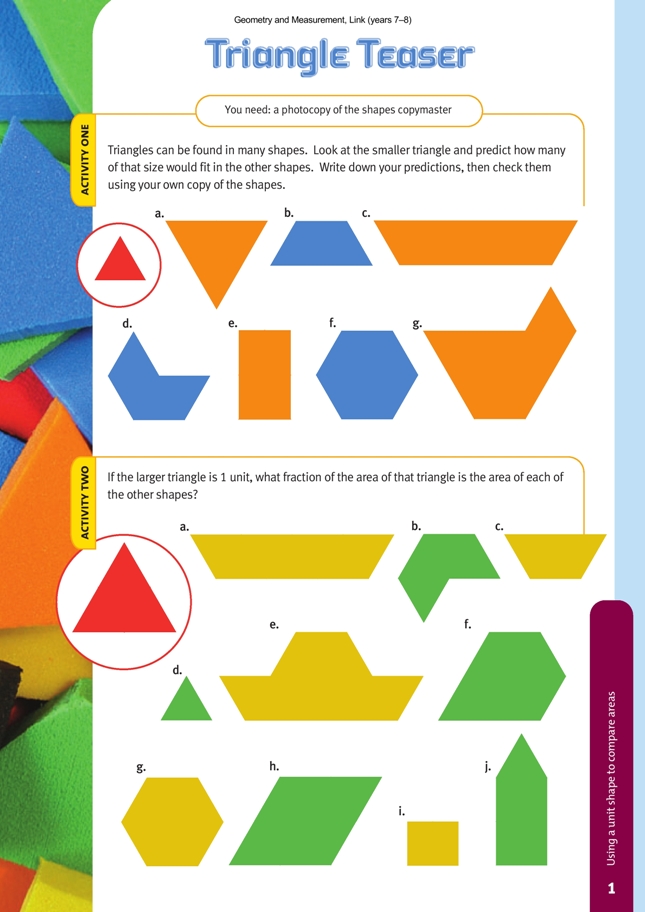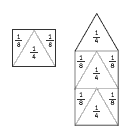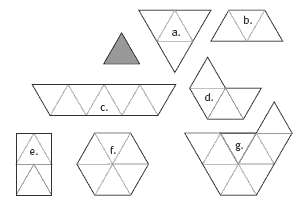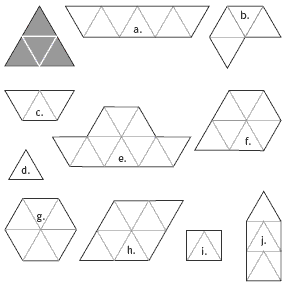This is a level 3 link measurement activity from the Figure It Out series. It relates to Stage 6 of the Number Framework.
Click on the image to enlarge it. Click again to close. Download PDF (514 KB)
use a unit shape to compare areas
Copymaster of Triangle Teaser
In these two activities, students estimate the areas of shapes by visualising how many triangular units it would take to cover them. To successfully complete the activities, students need an understanding of fractional numbers, including improper fractions (those greater than 1), how these can be represented visually, and how to add fractions such as quarters and eighths.
When introducing the activities, ask your students to explain what is meant by area. Explain that the challenge in today’s activity is to measure area using triangular
units. A key concept that needs to be taught is that any measurement involves a comparison between two things, one of which is the standard. Usually the standard is found on a ruler (a centimetre), a set of scales (a gram or kilogram), a thermometer (a degree), or some other device that is sold specifically as a measuring device. But any standard can be used for purposes of informal comparisons, as in the statement “The new warehouse covers an area the size of 3 rugby fields.” That’s where the triangles in this activity fit in. They are not standard units of measurement, but we can still use them to make valid statements about the relative sizes of various shapes.
Activity One
The students should visualise how many triangles will fit into each of the shapes before drawing lines on their copy of the copymaster. It’s the visualising process that helps them to see that measurement is about making comparisons, not about following mathematical rules. Once students have visualised the answers, they can cut out the small triangle, if necessary, and use it to check their predictions.
Note that the answer for part e is more difficult to visualise because the triangle units won’t fit without “cutting”. Some students may need to actually cut and rearrange the triangles before they can see what the answer is.
Activity Two
This activity is similar to the first in that it involves measuring a series of shapes, but this time, students work with a larger unit. If they find this difficult, discuss how the unit triangle could be divided into smaller parts that would more easily fit the different shapes. Ask “What fraction of the large triangle is each of the smaller parts?” (The small triangles are each 1/4 of the larger unit, and the trapezium is 3/4 of the larger unit.) Once the values of these parts of the unit triangle are known, students
can, for example, imagine the shape in part a divided up into small triangles or trapeziums, like this:
If students have difficulty with the visualising or the sketching of lines on their copy of the copymaster, they could make some of the large unit triangles, cut them up, and move the parts around to check their predictions. They could also use the triangles from shape sets.
As for part e in Activity One, parts i and j are more difficult than the others because the triangle unit needs to be further split before its area can be compared with each outline.
After the activity, encourage reflective thinking by asking questions such as:
- What strategies did you find helpful?
- Which questions were the most difficult? What made them so?
- Why do you think the standard units for measurement of area are square
- (such as square centimetres, square metres, or square kilometres) rather than another shape?
- What suggestions would you give someone who was about to start this activity?
Answers to Activities
Activity One
a. 4
b. 3
c. 7
d. 4
e. 4
f. 6
g. 9
Activity Two
a. = 7/4 = 1 3/4
b. 4/4 = 1
c. 3/4
d. 1/4
e. 10/4 = 2 1/2
f. 7/4 = 1 3/4
g. 6/4 = 1 1/2
h. 8/4 = 2
i. 2/4 = 1/2
j. 5/4 = 1 1/4





